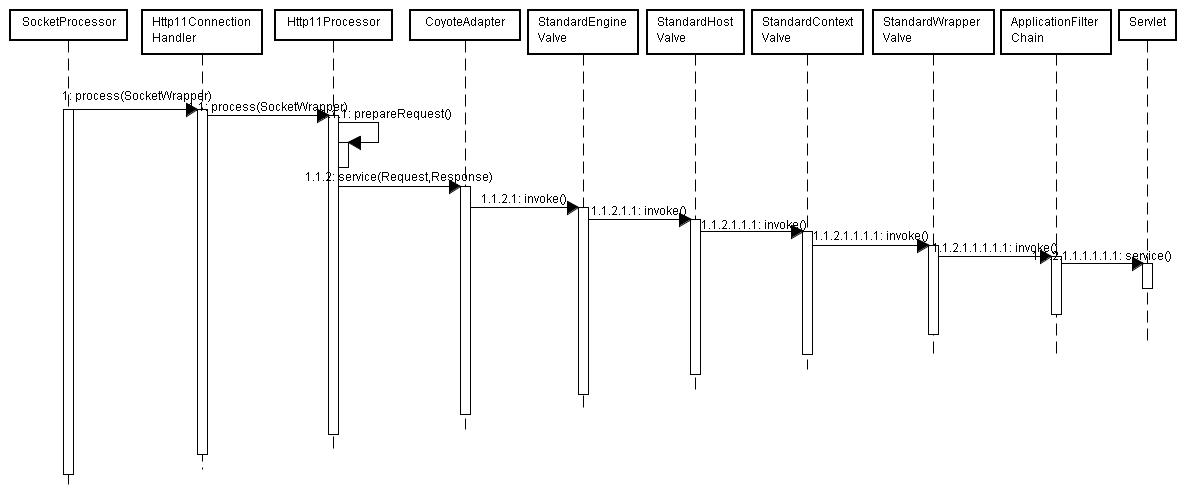在CoyoteAdapter的service方法中,主要干了2件事:
1. org.apache.coyote.Request -> org.apache.catalina.connector.Request extends HttpServletRequest
org.apache.coyote.Response -> org.apache.catalina.connector. Response extends HttpServletResponse
Context和Wrapper定位
2. 将请求交给StandardEngineValue处理
public void service(org.apache.coyote.Request req,
org.apache.coyote.Response res) {
//
postParseSuccess = postParseRequest(req, request, res, response);
//
connector.getService().getContainer().getPipeline().getFirst().invoke(request, response);
//
}
postParseRequest方法的代码片段
connector.getMapper().map(serverName, decodedURI, version,
request.getMappingData());
request.setContext((Context) request.getMappingData().context);
request.setWrapper((Wrapper) request.getMappingData().wrapper);
request通过URI的信息找到属于自己的Context和Wrapper。而这个Mapper保存了所有的容器信息,不记得的同学可以回到Connector的startInternal方法中,最有一行代码是mapperListener.start()。在MapperListener的start()方法中,
public void startInternal() throws LifecycleException {
setState(LifecycleState.STARTING);
findDefaultHost();
Engine engine = (Engine) connector.getService().getContainer();
addListeners(engine);
Container[] conHosts = engine.findChildren();
for (Container conHost : conHosts) {
Host host = (Host) conHost;
if (!LifecycleState.NEW.equals(host.getState())) {
registerHost(host);
}
}
}
在容器初始化和变化时都会触发监听事件,从而将所有容器信息保存在Mapper中。之所以叫Mapper,因为它的主要作用就是定位Wrapper,而我们在web.xml里也配了filter/servlet-mapping。
另外,由上面的代码可知,在随后的请求路线中,Engine可有Connector获取,Context和Wrapper可直接由Request获取,Host也可由Request获取。
public Host getHost() { return ((Host) mappingData.host); }
上面的代码中还涉及到了两个很重要的概念--Pipeline和Value,我们不妨先一睹Container的调用链和时序图。


对于每个引入的http请求,连接器都会调用与其关联的servlet容器所绑定的一系列阀门(Value)的invoke方法,基础阀门(StandardXxValue)都在尾端,然后会逐步调用子容器的阀门。为什么必须要有一个Host容器呢?
在tomcat的实际部署中,若一个Context实例使用ContextConfig对象进行设置,就必须使用一个Host对象,原因如下:
使用ContextConfig对象需要知道应用程序web.xml文件的位置,在其webConfig()方法中会解析web.xml文件
// Parse context level web.xml
InputSource contextWebXml = getContextWebXmlSource();
parseWebXml(contextWebXml, webXml, false);
在getContextWebXmlSource方法里
// servletContext即core包下的ApplicationContext
url = servletContext.getResource(Constants.ApplicationWebXml);
在getResource方法里
String hostName = context.getParent().getName();
因此,除非你自己实现一个ContextConfig类,否则,你必须使用一个Host容器。
管道(Pipeline)包含该servlet容器将要调用的任务。一个阀(Value)表示一个具体的执行任务。在servlet容器的管道中,有一个基础阀,但是,可以添加任意数量的阀。阀的数量指的是额外添加的阀数量,即不包括基础阀。有意思的是,可以通过server.xml来动态添加阀。
管道和阀的工作机制类似于servlet编程中的过滤器链和过滤器,tomcat的设计者采用的是链表数据结构来实现的链条机制,引入了一个类叫ValueContext。值得注意的是,基础阀总是最后执行。
请求最终会被引导到StandardWrapper,本人也是首先从Wrapper这一层来入手Container的,直接看StandardWrapperValue的invoke方法
@Override
public final void invoke(Request request, Response response) {
//
requestCount++;
StandardWrapper wrapper = (StandardWrapper) getContainer();
Servlet servlet = null;
Context context = (Context) wrapper.getParent();
//
// Allocate a servlet instance to process this request
try {
if (!unavailable) {
servlet = wrapper.allocate();
}
} catch (Exception e) {}
//
// Create the filter chain for this request
ApplicationFilterFactory factory =
ApplicationFilterFactory.getInstance();
ApplicationFilterChain filterChain =
factory.createFilterChain(request, wrapper, servlet);
//
// Call the filter chain for this request
// NOTE: This also calls the servlet's service() method
//
filterChain.doFilter(request.getRequest(), response.getResponse());
//
// Release the filter chain (if any) for this request
if (filterChain != null) filterChain.release();
// Deallocate the allocated servlet instance
if (servlet != null) wrapper.deallocate(servlet);
// If this servlet has been marked permanently unavailable,
// unload it and release this instance
try {
if ((servlet != null) &&
(wrapper.getAvailable() == Long.MAX_VALUE)) {
wrapper.unload();
}
} catch (Throwable e) { }
//
}
上面代码中最重要的三处逻辑就是servlet实例的获取与卸载和filter链调用。我们先看卸载servlet实例的代码
@Override
public void deallocate(Servlet servlet) throws ServletException {
// If not SingleThreadModel, no action is required
if (!singleThreadModel) {
countAllocated.decrementAndGet();
return;
}
// Unlock and free this instance
synchronized (instancePool) {
countAllocated.decrementAndGet();
instancePool.push(servlet);
instancePool.notify();
}
}
我们不考虑SingleThreadModel模型,因为较新版本的tomcat已经不用这种模型了(只有很老的版本才用),显然,通过上面的代码可以知道,基本上什么都不用做,而Single Thread Model常用的是池化模型(maxInstances=20)。下面给出加载servlet实例的代码
@Override
public Servlet allocate() throws ServletException {
boolean newInstance = false;
// If not SingleThreadedModel, return the same instance every time
if (!singleThreadModel) {
// Load and initialize our instance if necessary
if (instance == null || !instanceInitialized) {
synchronized (this) {
if (instance == null) {
try {
if (log.isDebugEnabled()) {
log.debug("Allocating non-STM instance");
}
// Note: We don't know if the Servlet implements
// SingleThreadModel until we have loaded it.
instance = loadServlet();
newInstance = true;
if (!singleThreadModel) {
// For non-STM, increment here to prevent a race
// condition with unload. Bug 43683, test case
// #3
countAllocated.incrementAndGet();
}
} catch (ServletException e) {
throw e;
} catch (Throwable e) {
ExceptionUtils.handleThrowable(e);
throw new ServletException(sm.getString("standardWrapper.allocate"), e);
}
}
if (!instanceInitialized) {
initServlet(instance);
}
}
}
if (singleThreadModel) {
if (newInstance) {
// Have to do this outside of the sync above to prevent a
// possible deadlock
synchronized (instancePool) {
instancePool.push(instance);
nInstances++;
}
}
} else {
if (log.isTraceEnabled()) {
log.trace(" Returning non-STM instance");
}
// For new instances, count will have been incremented at the
// time of creation
if (!newInstance) {
countAllocated.incrementAndGet();
}
return instance;
}
}
synchronized (instancePool) {
while (countAllocated.get() >= nInstances) {
// Allocate a new instance if possible, or else wait
if (nInstances < maxInstances) {
try {
instancePool.push(loadServlet());
nInstances++;
} catch (ServletException e) {
throw e;
} catch (Throwable e) {
ExceptionUtils.handleThrowable(e);
throw new ServletException(sm.getString("standardWrapper.allocate"), e);
}
} else {
try {
instancePool.wait();
} catch (InterruptedException e) {
// Ignore
}
}
}
if (log.isTraceEnabled()) {
log.trace(" Returning allocated STM instance");
}
countAllocated.incrementAndGet();
return instancePool.pop();
}
}
我们看到了:If not SingleThreadedModel, return the same instance every time
最后,我们来看看filterChain的执行,
@Override
public void doFilter(ServletRequest request, ServletResponse response)
throws IOException, ServletException {
internalDoFilter(request,response);
}
private void internalDoFilter(ServletRequest request,
ServletResponse response)
throws IOException, ServletException {
// Call the next filter if there is one
if (pos < n) {
filter.doFilter(request, response, this);
}
// We fell off the end of the chain -- call the servlet instance
servlet.service(request, response);
}
显然,在调用web.xml里配的某个servlet时,都会先依次调用在web.xml里配的filter,这可谓是责任链设计模式的一种经典实现,方法的最后会调用servlet.service(request, response)。
一个Servlet到底有多少个实例呢,我们来看看官方的说明,在Servlet规范中,对于Servlet单例与多例定义如下:
“Deployment Descriptor”, controls how the servlet container provides instances of the servlet.For a servlet not hosted in a distributed environment (the default), the servlet container must use only one instance per servlet declaration. However, for a servlet implementing the SingleThreadModel interface, the servlet container may instantiate multiple instances to handle a heavy request load and serialize requests to a particular instance.
上面规范提到,
如果一个Servlet没有被部署在分布式的环境中,一般web.xml中声明的一个Servlet只对应一个实例。
而如果一个Servlet实现了SingleThreadModel接口,就会被初始化多个实例,默认20个
补充以下,一个Servlet在web.xml声明两次,会产生两个实例。
好了,现在你可以把前文中Connector执行过程和本文的Container执行过程结合起来了。我始终相信,深入一点,你会更快乐。


